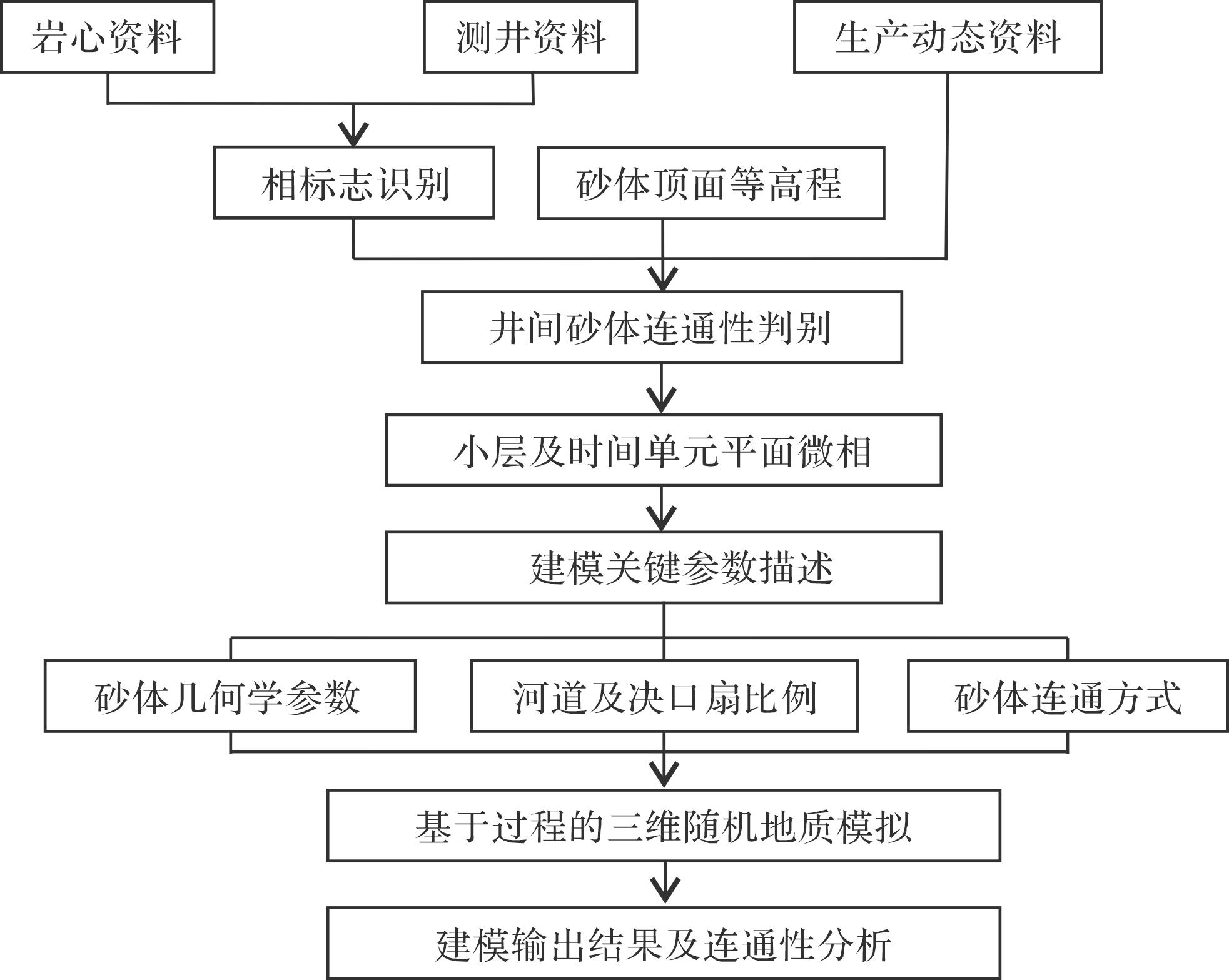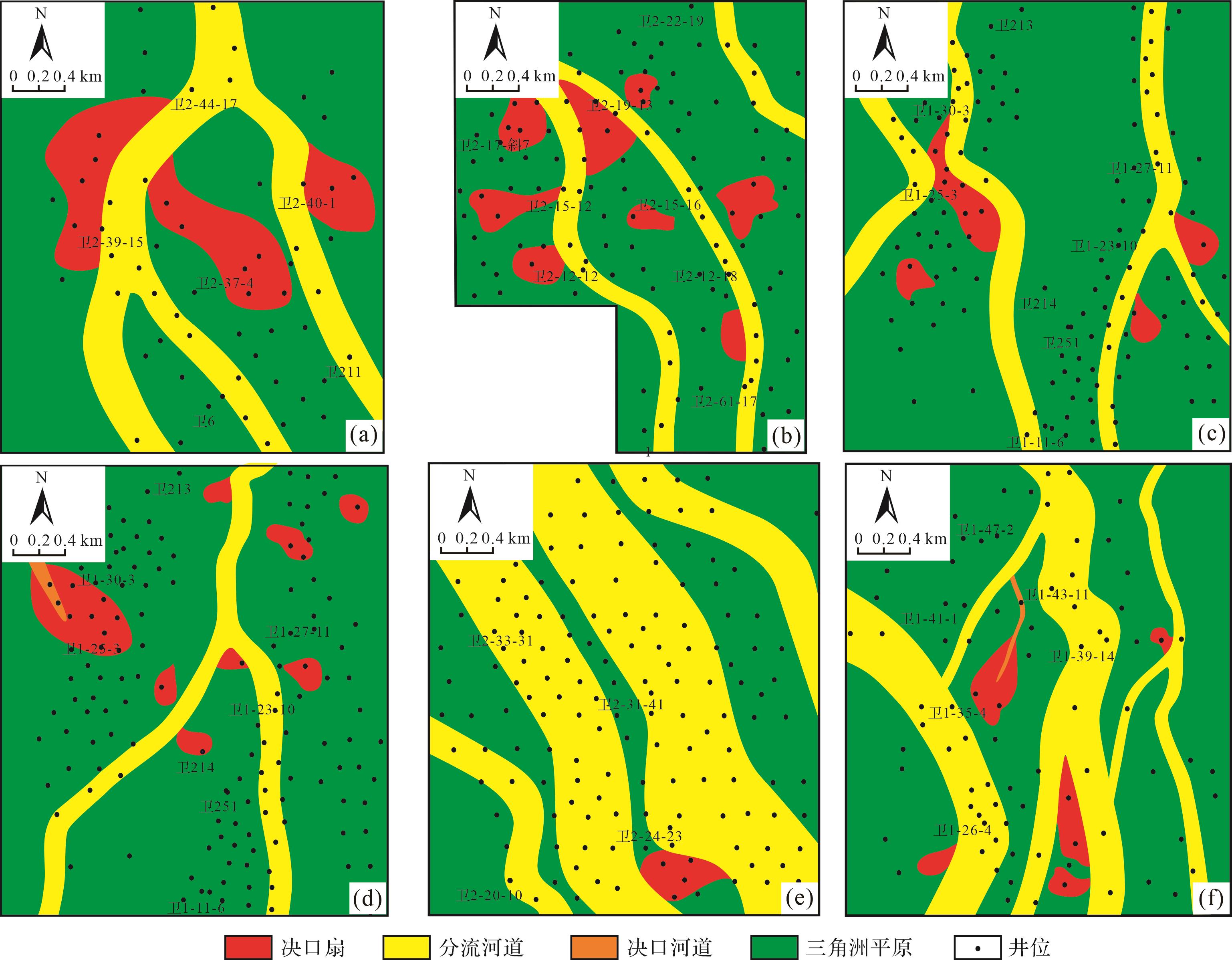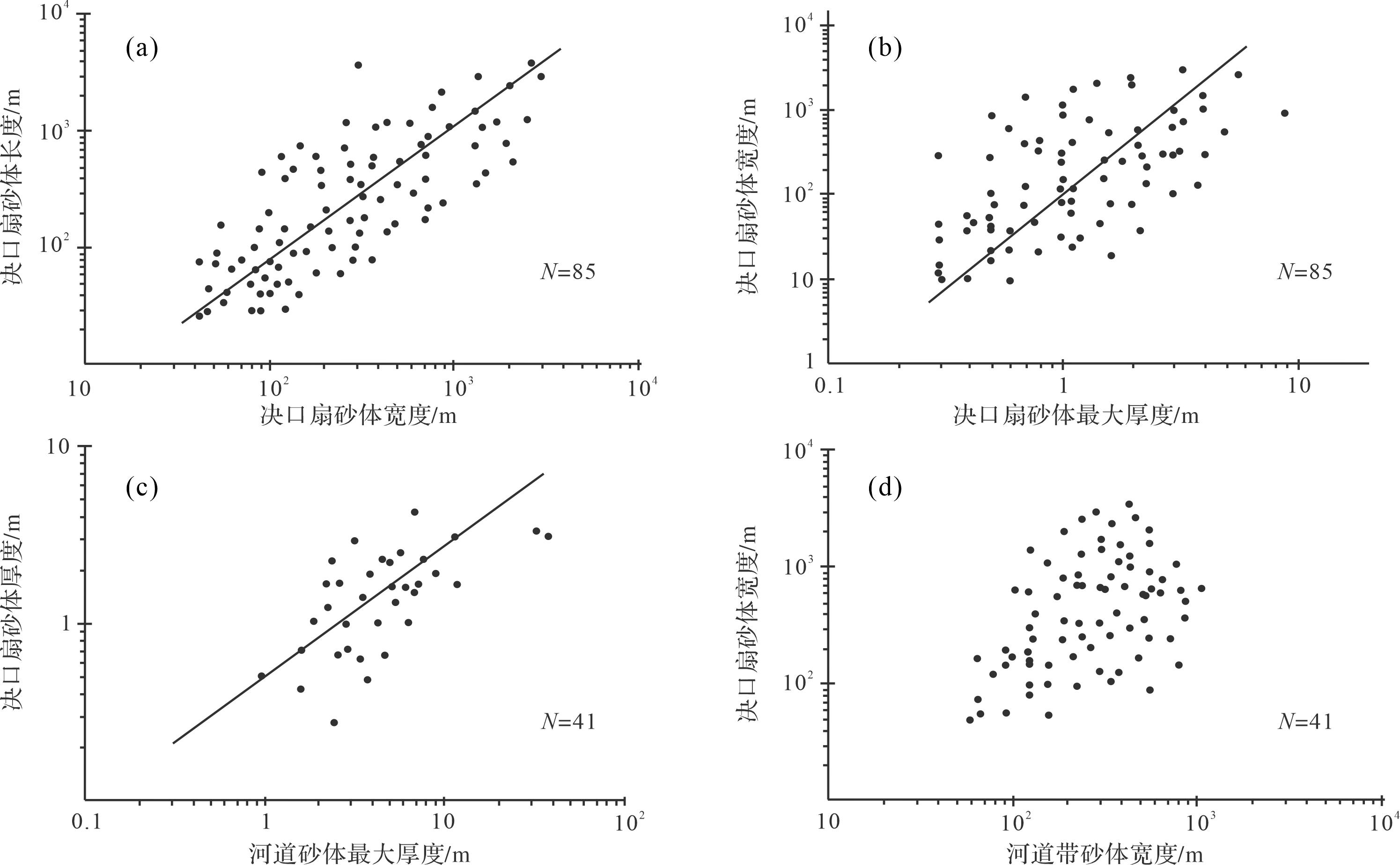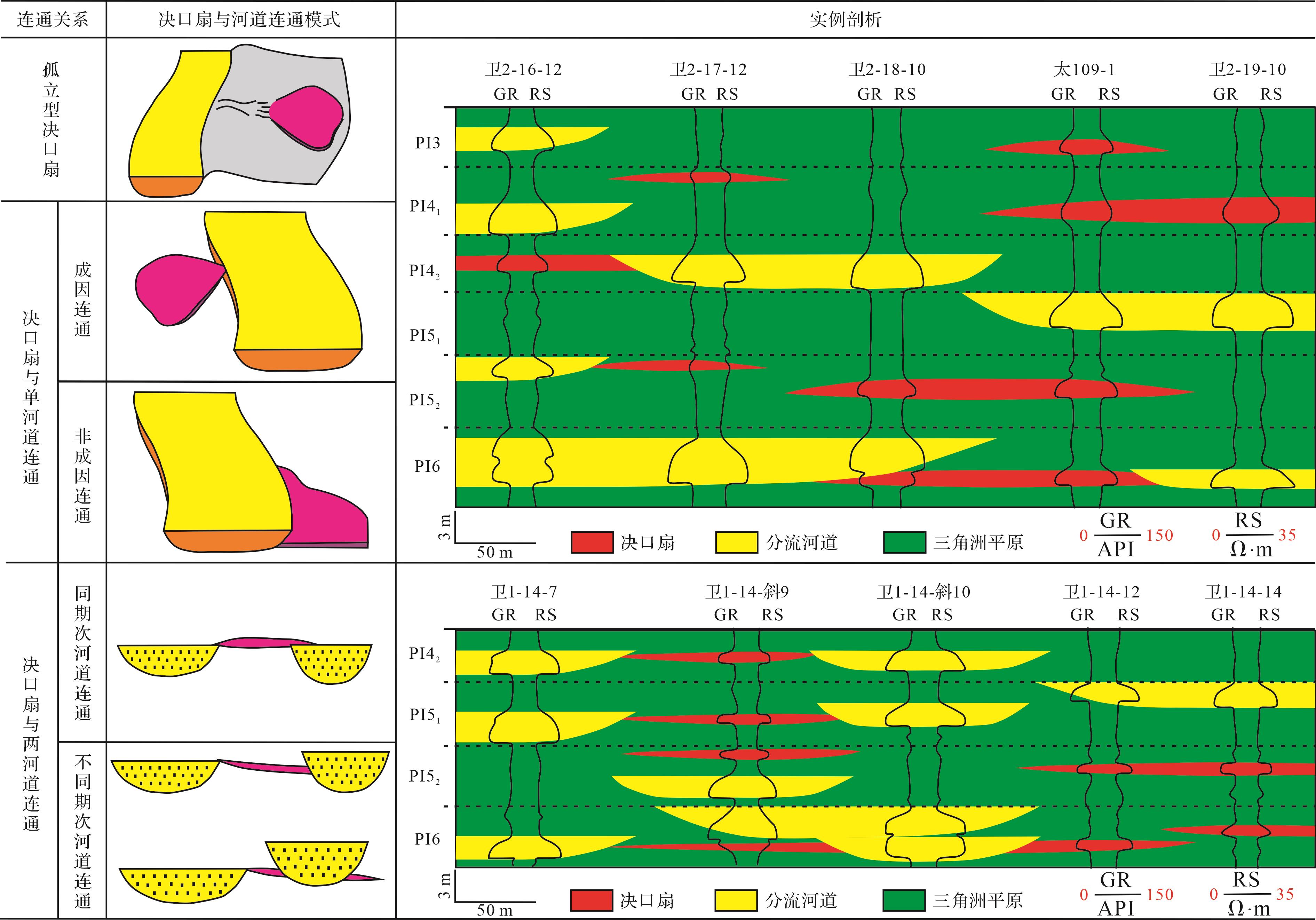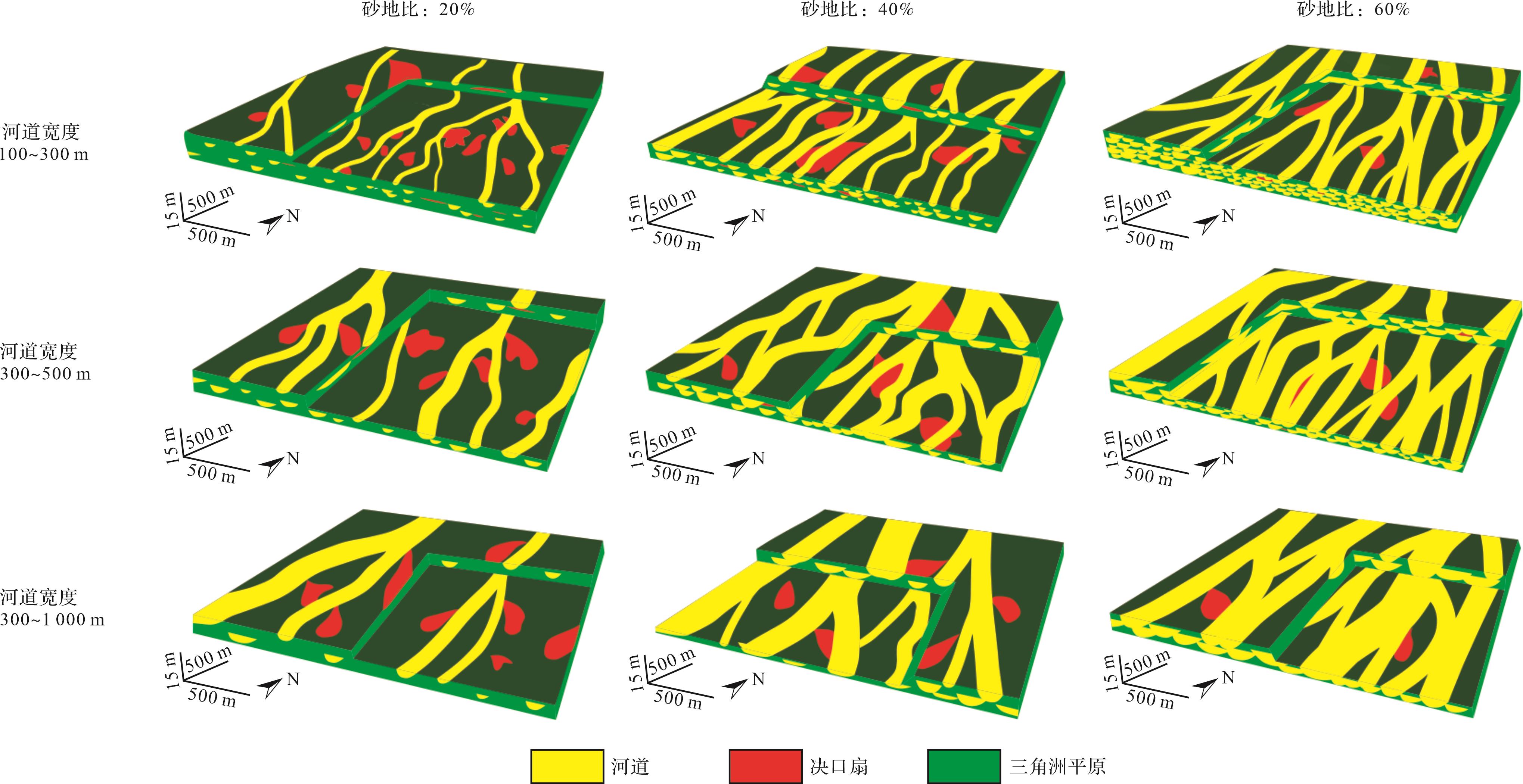HTML
-
决口扇沉积作为河流沉积体系中的一种典型沉积微相,通常形成相对多孔隙和渗透性的砂体,可作为油气藏的生产单元[1⁃3]。诸多油气田开发后期的实践表明[4⁃5],决口扇砂体往往是剩余油气分布的有利储集空间,对决口扇沉积进行深入研究有利于老油田挖潜增储并延长衰竭性老油井的开采寿命。近年来,国外学者[6⁃9]逐渐加大了对决口扇沉积的研究力度,研究方向主要侧重于决口扇沉积特征、演化模式、露头砂体叠置关系以及定性识别标准,极大地丰富了决口扇沉积理论;国内学者[10⁃12]对于决口扇沉积的研究相对较晚,早期主要集中于决口扇砂体沉积模式及定量识别方法,但随着剩余油注水开发的迫切需求,后期关注的重点逐渐转向决口扇砂体与其邻近河道之间的连通关系。
尽管国内外学者在决口扇沉积开展了诸多方面的研究,但决口扇沉积对以分流河道为主的三角洲平原亚相砂体连通性的影响程度尚未开展定量化研究,相关地质认识存在不足。砂体连通性又称几何连通性,是指不同砂体之间几何接触的程度,一般不考虑其流体连通性。学者们普遍认为[13⁃14],决口扇沉积物将增加砂体的横向连通性,可作为“桥梁”连通同一水系分支内不同的分流河道砂体,在一定程度上能够提高油藏性能,然而在特殊情况下也可能形成孤立型决口扇砂体(如洪水期过后河道废弃,被后续泥质沉积物充填),需要设计水平井穿透这些区域才可能生产油气。因此,决口扇沉积物在控制河流沉积体系砂体连通性方面的重要性已经成为油气田开发后期研究的主要难题之一。
基于此,本文以松辽盆地三肇凹陷卫星油田葡萄花油层为例,利用密井网区精细解剖,实现决口扇沉积在三角洲平原亚相中砂体连通性的定量表征,明确决口扇沉积对三角洲平原亚相砂体连通性的影响程度。
-
本文以卫星油田葡萄花油层5处密井网区(卫12井区、卫21井区、太25井区、太109井区及卫214井区)内4口井岩心、552口测井及生产动态资料为数据基础。其中,卫12井区面积13.5 km2,共有钻井75口,平均井距220 m,最小井距为110 m;卫211井区面积7.2 km2,共有钻井60口,平均井距220 m,最小井距为110 m;太25井区面积12.5 km2,共有钻井168口,平均井距100 m,最小井距70 m;太109井区面积12.5 km2,共有钻井121口,平均井距150 m,最小井距70 m;卫214井区面积15 km2,共有钻井128口,平均井距150 m,最小井距50 m。
研究主要采用了岩心观测、测井识别、井间连通性分析及三维地质建模等方法(图2)。
(1) 利用岩心资料描述决口扇砂体典型沉积特征,并建立测井相识别标志。
(2) 以测井微相模式为指导,识别开发区各小层和时间单元井点处沉积微相,并绘制小层和时间单元的沉积微相图。沉积微相图绘制过程中,注采井之间利用生产动态资料中注采曲线形态相似性来判断井间砂体连通性;非注采井之间由于开发区内古地形坡度和井距均较小,利用砂体顶面等高程和测井曲线形态相似性原理来判别井点之间砂体连通性,进而绘制5处开发区内PⅠ3~PⅠ6小层或时间单元沉积微相图。
(3) 以小层或时间单元沉积微相图为依据,刻画决口扇砂体几何学参数(长度、宽度、厚度),统计决口扇砂体在三角洲平原亚相砂体中的比例,分析分流河道与决口扇的砂体几何学参数之间的定量关系及砂体连通方式。
(4) 利用河流系统随机模拟软件FLUMY进行三维地质建模,并定量输出各建模结果的砂体连通概率。由于FLUMY软件是以基于过程的方式来随机模拟河流的时间演化,无法直接量化输入决口扇砂体几何学参数和砂体比例等参数,只能依托于河流体系,通过控制输入分流河道砂体宽度、厚度及分流河道砂体比例的方式间接实现模拟功能,具体包括:①在明确河道砂体几何学参数及河流坡度条件下,实现河道中心线随两岸水流速度的迁移变化;②可能发生在模拟区域内的决口河道,并且优先发生在最大水流速度扰动的位置;③通过调整砂地比、河道砂体比例、河道宽度等参数来控制地质过程和因素,进而模拟出与河道有成因关系的沉积物规模,如决口扇;④利用最大砂体网格数与砂体总网格数的比值,输出建模区域范围内砂体连通概率。
(5) 分别统计含决口扇和不含决口扇条件下三角洲平原亚相砂体连通性变化,分析决口扇沉积对三角洲平原亚相砂体连通性的定量影响。
-
地层层序中各砂体之间的连通性是其规模、形状、比例及空间组合的综合响应结果[16]。为精细刻画决口扇砂体的上述沉积结构要素,本文基于5处密井区沉积微相精细解剖来实现决口扇沉积结构的定量表征。
-
取心井岩心相特征识别是研究决口扇沉积的重要手段。根据研究区4口取心井岩心资料,决口扇沉积底部常见弱冲刷面,一般发育小型交错层理、平行层理、水平层理和块状层理(图3a),岩性以细粉砂岩、粉砂岩和泥质粉砂岩为主,孔隙度7.3%~27.9%,渗透率(0.92~25.65)×10-3 μm,整体表现为低孔低渗储层。
以取心井岩心资料为基础,结合测井曲线响应特征建立测井相识别标志,可有助于决口扇微相砂体的测井识别。研究区分流河道与决口扇在测井微相上具有显著差别,分流河道砂体在测井曲线表现为钟形或箱形,整体高幅度差,电阻率25~35 Ω∙m,自然伽马一般小于50 API,单期河道厚度2.0~5.0 m,复合河道可达10.1 m;决口扇砂体在测井曲线上则一般表现为钟形或手指状,顶部渐变底部突变,中等幅度差,电阻率15~25 Ω∙m,自然伽马一般为50~100 API,单期扇体厚度一般小于2.0 m,复合扇体一般具1~2期叠置(图3b),厚度2.0~4.0 m,局部坡度较大方向可形成3期叠置,厚度可达5.0 m。
-
基于测井微相模式,针对5处密井区6个时间单元552口开展了逐井逐层的微相识别,刻画了时间单元沉积微相平面图。沉积微相平面图绘制过程中,针对注采井之间,根据水井注水量曲线与采油井产液量曲线形态之间的相似性来判断其井间连通性;而对于非注采井之间,由于分流河道和决口扇剖面形态分别表现为“顶平底凹”和片状的特点,且开发区内井距和古地形坡度均较小,利用砂体顶面等高程原理,并结合测井曲线形态相似性,进行井间连通性判别。图4展示了各密井区部分典型的沉积微相平面图的刻画结果,可以看出,决口扇主要分布于分流河道两侧或河道分叉处,整体呈朵叶形状或受河道带切叠而呈半月形。

Figure 4. Typical sedimentary microfacies of the Putaohua oil layer in the development block in the Weixing oilfield
基于5处密井区30个时间单元沉积微相平面图,分别统计了85处决口扇砂体的最大长度、最大宽度和厚度,其中决口扇长度和宽度基于1/2井距来约束,厚度可由测井解释数据直接统计得出。同时为分析决口扇砂体与其成因相联系的分流河道在砂体几何学参数之间的相关性,又分别统计了决口扇测井钻遇厚度和其成因相关的分流河道砂体钻遇厚度。分析表明:(1)决口扇砂体长度范围50~3 000 m,宽度范围50~2 500 m,长宽比值约为1.2(图5a);(2)决口扇砂体井点钻遇厚度0.2~5.0 m,宽厚比400~600,平均宽厚比约为500(图5b);(3)决口扇砂体厚度与其成因分流河道砂体厚度呈正相关,分流河道厚度与决口扇厚度比值为1.2~11.2,平均值为3.5(图5c);4)决口扇与分流河道砂体宽度比为1.6~12.5,平均值为5.4(图5d)。
-
决口扇沉积物与分流河道之间具有不同的砂体几何学形态和规模,两者之间的比例关系的不同必然会产生砂体连通性的差异[16⁃17]。由于密井区井网分布相对较为均匀,因此本文通过统计密井区钻遇决口扇砂体井数与钻遇分流河道砂体井数之间的比值来明确两者之间的砂体比例。5处密井区30个时间单元沉积微相平面图的统计结果表明,决口扇钻遇比例为2%~38%,且钻遇比例随着三角洲相地层中分流河道规模增大或数量增加而降低(图6a),两者之间为线性负相关,线性关系式为:
A 决口扇=-0.272 3A 分流河道+0.261 3(1) 式中:A决口扇为决口扇的钻遇比例,A分流河道为分流河道的钻遇比例,相关系数R2=0.43。
同样采用上述方法,统计了决口扇钻遇比例与地层平均砂地比之间的关系,从图6b中可以看出,随着三角洲相地层中砂地比增加,决口扇的比例逐渐减小,两者之间的线性关系式为:
A 决口扇=-0.315 2R +0.284 7(2) 式中:R为地层平均砂地比,A决口扇为决口扇钻遇比例,相关系数R2=0.39。
沉积分析表明,当河道砂体比例较低时,一般河流规模相对较小,分流河道带之间垂向叠置程度较弱,决口扇得以完整保存;而随着河流规模的逐渐增大,砂地比变高,河流侵蚀性增强,对早期形成的决口扇沉积物进行改造和破坏,导致决口扇比例相对较低。
-
除决口扇砂体几何学参数和沉积比例外,决口扇与分流河道砂体之间的连通方式也可能影响砂体连通性。一般而言,在构建地下河流层序模型时,决口扇沉积物与河道砂体之间连通的情况较为常见,然而两者之间也存在不连通的情况,如河流决口处泥质含量丰富且河流能量持续减弱,导致决口处被后续细粒沉积物充填等。
笔者基于5处密井开发区的连井相剖面追踪和平面微相识别,通过分析决口扇与分流河道砂体在测井微相上的垂向组合特征及平面接触关系,总结出决口扇与分流河道之间的3型5类连通关系(图7)。
1) 孤立型决口扇
决口扇砂体与分流河道砂体之间不连通,主要分布于地层平均砂地比小于30%的时间单元内,一般规模相对较小,仅占研究区决口扇整体数量的5%。
2) 决口扇与单河道之间连通
(1)成因连通:分流河道与其所形成的决口扇砂体之间相连通,主要分布于地层平均砂地比小于50%的时间单元内,占研究区决口扇整体数量的70%,为研究区连通河道方式的主要类型。
(2)非成因连通:分流河道侵蚀其他分流河道所形成的决口扇而导致两者之间的连通,主要分布于地层平均砂地比大于20%的时间单元内,尤其是地层平均砂地比大于50%时,决口扇与分流河道砂体之间以非成因连通为主。
3) 决口扇与两河道之间连通
(1)决口扇连通同期分流河道:决口扇规模大于两分流河道之间的距离,一般出现在河流规模大且与相邻分流河道距离较近的决口河段附近。
(2)决口扇连通不同时期分流河道:表现为后期的分流河道切叠决口扇边部或中部2种方式。
3.1. 决口扇沉积相识别标识
3.2. 决口扇砂体几何学参数定量表征
3.3. 决口扇砂体钻遇比例定量表征
3.4. 决口扇砂体连通方式定量表征
-
以测井解释资料为基础,利用FLUMY软件开展了三角洲平原亚相的地层建模,在模拟过程中假设分流河道和决口扇均为渗透性砂岩,这些渗透性砂岩置身于非渗透性细粒沉积背景的三角洲平原之中。建模区域为长方体笛卡尔网格构建的区块地层,设置区块面积8 km2,地层厚度10~20 m,网格精度平面达到0.5 m,垂向精度0.1 m。分流河道和决口扇则分别被赋予不同类型的网格族群,每一处独立砂体又分别赋予不同的代码,砂体则是由一系列基于面接触的网格构成。
建模过程中综合考虑到了砂体几何学参数和各沉积微相的比例。由于决口扇是由FLUMY软件模拟河流形态动力学的结果,无法直接利用决口扇砂体几何学参数和比例进行模拟,只能借助与决口扇有成因联系的分流河道各项参数进行间接模拟。因此,决口扇微相的比例可根据式(2)通过输入砂地比数值来调整,决口扇砂体几何学参数则可通过其输入成因河道带的宽度和测井厚度进行调整,其输入的变量参数主要包括:分流河道宽度和砂地比。其中河道宽度设置了3个参数值,分别为:100~300 m,300~500 m,300~1 000 m;砂地比则以10%为单元设置了6个参数值,共有18种不同的输入参数组合。
-
FLUMY软件建模过程中,决口扇沉积物的比例控制在2%和30%之间变化,平均值约为12%。一般而言,决口扇沉积物的比例随着分流河道砂体比例或砂地比的增加而减少,在相同砂地比的前提下,意味着分流河道规模越大则分流河道数量就越少,砂体叠置程度越低;反之,分流河道规模越小则其数量就越多,砂体叠置程度越高。
在三维网格模型中,当砂体总网格数一定时,若砂体数量由少变多,则意味着原本连通在一起的砂体变得零散分布;反之,若砂体数量由多变少,则意味着砂体集中分布在一处,砂体之间趋于连通。因此,在给定砂地比的前提下,连通砂体的数量和大小可描述为3种情况:(1)三角洲平原亚相中砂体规模小,数量多,砂体之间分散,连通性差或不连通;(2)三角洲平原亚相砂体规模大,叠置砂体发育为主,数量较少,砂体连通性强;(3)三角洲平原亚相砂体完全连通,砂体数量为1。
基于此,利用FLUMY软件进行了三维地质建模。具体建模步骤为:
(1) 地层模型建立:设定地层厚度为10~20 m,其厚度大体接近研究区PⅠ3~PⅠ6小层的总厚度。
(2) 测井曲线离散化:井点数据离散化的目的在于给井曲线穿过的网格单元赋值,将井点信息作为输入值,进而控制井间属性分布。
(3) 变差函数分析:通过调节主变差函数方向控制沉积物源方向,在此设定物源方向为北部;调节次变差函数方向控制垂直物源方向,调节垂向变差函数控制砂体厚度变化趋势。
(4) 沉积相建模:采用基于目标形成过程的随机模拟方法,分别输入不同砂地比数据及河道带宽度数据。
图8分别展示了不同河道宽度和砂地比条件下的部分典型三维随机建模结果,可以看出在相同砂地比条件下,随着河道规模增加,决口扇数量减少但规模增大,而在相同河道规模条件下,随着砂地比增加,决口扇规模和数量逐渐减少。
为厘清决口扇沉积在三角洲平原亚相砂体连通性中的影响程度,需分别对含决口扇沉积和不含决口扇沉积的三角洲平原亚相进行砂体连通概率统计,其中砂体连通概率采用了最大连通砂体体积与砂体总体积之间的比值来计算得出[18],即FLUMY软件中建模区域内的最大连通砂体网格数与砂体总网格数之间的比值。218次建模结果统计表明,随着砂地比增加,三角洲平原亚相砂体连通性整体逐渐增强,但含决口扇沉积的三角洲平原亚相在砂地比低于30%条件下,其砂体连通性远强于不含决口扇沉积的三角洲平原亚相,而当砂地比达到40%时,两者之间砂体连通性差距极小,几乎可以忽略不计(图9),决口扇沉积对三角洲平原亚相砂体连通性的改善作用随着砂地比增加而减少(表1)。分析认为,当地层平均砂地比高于30%时,河道带数量多或规模大,砂体叠置程度较强,不同分支河道之间无需决口扇的“桥梁”作用仍可实现砂体之间连通,甚至在一定程度上破坏决口扇沉积物的保存,从而导致决口扇沉积影响权重的下降;当地层平均砂地比低于30%时,河道带数量减少或规模变小,决口扇较为发育,能够概率性连通两条分流河道,从而起到改善三角洲平原亚相砂体连通性的重要作用。

Figure 9. Relationship between the net⁃to⁃gross and sand body connectivity probability of delta plain subfacies
砂地比 河道宽度/m 三角洲平原亚相砂体连通概率(均值) 砂体连通性变化(含决口扇连通概率/不含决口扇连通概率) 不含决口扇 含决口扇 0.1 100~300 0.01 0.10 10 0.1 300~500 0.01 0.13 13 0.1 300~1 000 0.02 0.18 9 0.2 100~300 0.02 0.16 8 0.2 300~500 0.04 0.32 8 0.2 300~1 000 0.06 0.51 8.50 0.3 100~300 0.21 0.52 2.48 0.3 300~500 0.53 0.64 1.21 0.3 300~1 000 0.66 0.78 1.18 0.4 100~300 0.81 0.84 1.04 0.4 300~500 0.93 0.95 1.02 0.4 300~1 000 0.96 0.99 1.03 0.5 100~300 1.00 1.00 1.00 0.5 300~500 1.00 1.00 1.00 0.5 300~1 000 1.00 1.00 1.00 -
决口扇沉积是地下河流层序的常见组成部分[19⁃20],在各种油田开发实例中均需进行连通性评价,如地下油气勘探、油气生产、地热开发等,其扇体规模、厚度、沉积比例、储层物性、连通方式等都决定了其所在地层的砂体连通性。
决口扇是洪水期过量的河水在天然堤处决口或在天然堤低处溢出,从而在天然堤下坡及洪泛平原的外缘上形成的扇状堆积物。一般而言,决口扇规模受河流类型、河流流量、决口处地形坡度、决口频率等因素影响,尤其在三角洲地层中,低缓的地形条件和较稳定的物源供给条件,使得单个决口扇规模与分流河道规模表现出中—高度的正相关,但随着河道带宽度增加,沉积体系内的决口扇数量急剧减少,导致决口扇整体分布范围缩小,降低了井点钻遇的概率。因此,在利用FLUMY软件进行模拟数据和建模输出时,主要通过直接控制分流河道带宽度和砂地比来间接控制决口扇砂体规模及比例。因受限于研究区块井网密度,分流河道和决口扇砂体几何学规模在刻画过程中存在1/2井距误差,在一定程度上可能影响建模结果的准确性,因此建模过程中分流河道宽度采用了范围数值进行了约束,以此尽量减少井距误差的影响。此外,砂体连通性是研究流体连通性的前提和依据,明确决口扇与分流河道砂体之间的连通关系,有助于刻画剩余油气潜在富集部位,为剩余油气勘探提供理论依据,从而指导井网部署。然而,砂体之间连通未必就意味着流体连通,需要进一步考虑决口扇内部岩性和物性的非均质性才能分析出剩余油气的优势聚集部位,这是有待进一步研究的科学问题。
4.1. 建模原理及输入参数
4.2. 输出结果及连通性分析
4.3. 不足及建议
-
(1) 卫星油田葡萄花油层决口扇砂体长50~3 000 m,宽50~2 500 m,厚度0.2~5.0 m,与分流河道在砂体几何学参数呈中—高度正相关,砂体钻遇比例呈负相关。
(2) 三角洲地层中决口扇与分流河道存在3型5类砂体连通关系:①孤立型决口扇;②决口扇与单河道连通(成因连通和非成因连通);③决口扇与两河道连通(连通同期次河道和连通不同期次河道)。
(3) 决口扇对三角洲平原亚相砂体连通性的影响程度随着分流河道数量增多和规模增大而减少,主要改善了砂地比低于30%的中小型三角洲平原亚相砂体连通性。

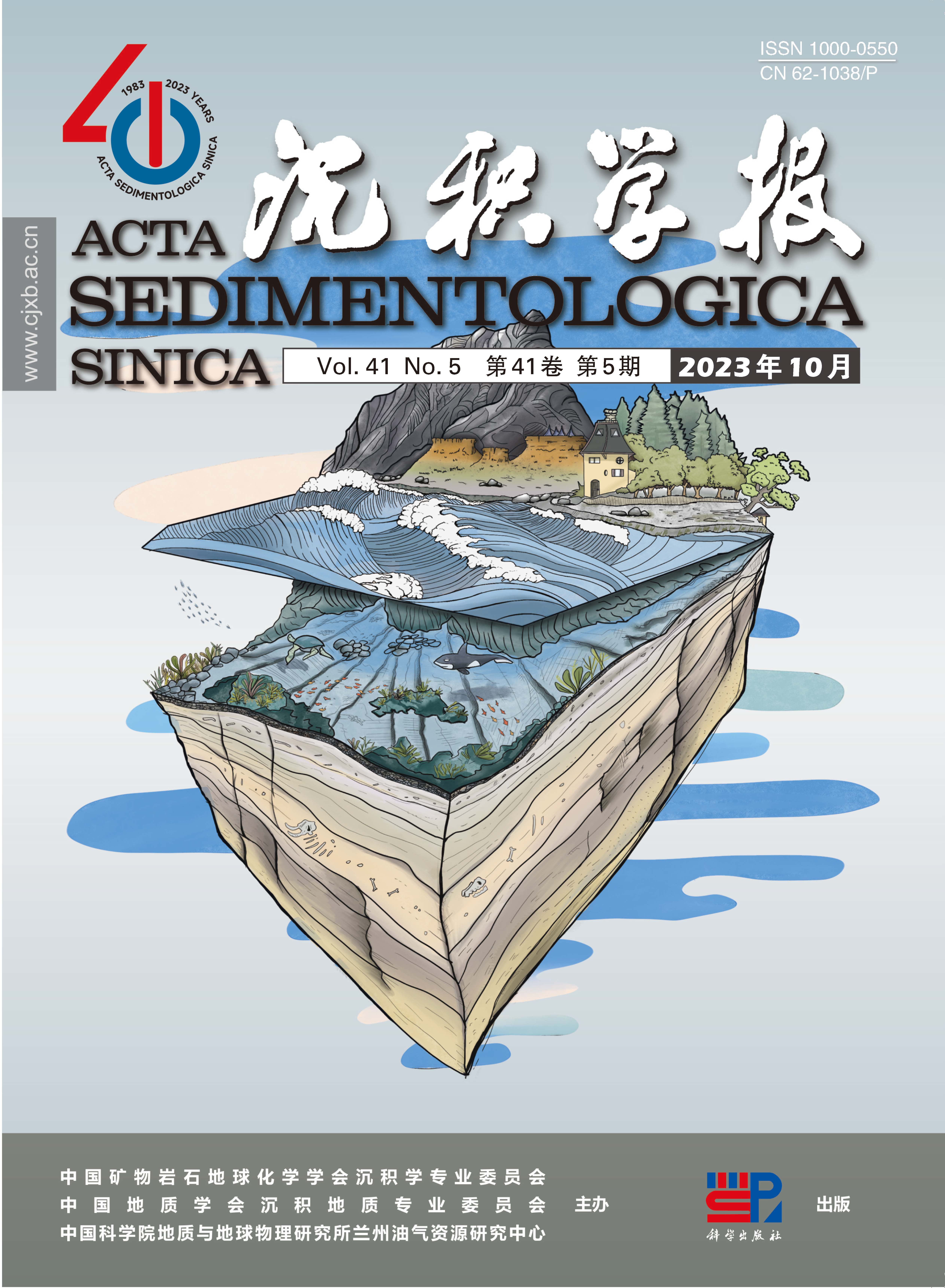












 DownLoad:
DownLoad:
